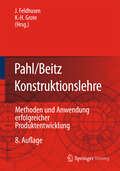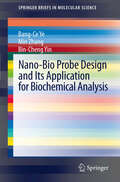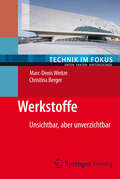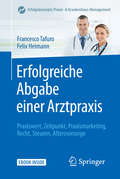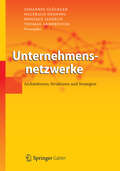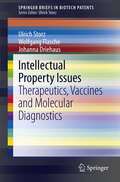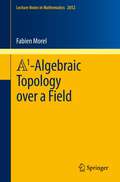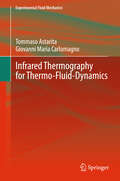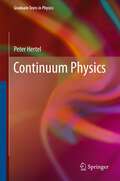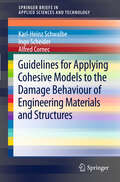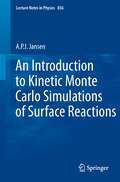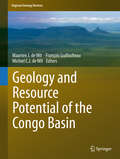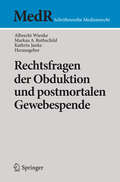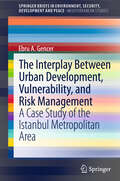- Table View
- List View
Baustoff und Konstruktion: Festschrift zum 60. Geburtstag von Harald Budelmann
by Heiko Twelmeier Reinhard NothnagelExperten aus dem In- und Ausland erläutern in ihren Artikeln die Entwicklung und den Einsatz der Betontechnologie - insbesondere moderner Hochleistungsbetone. Ferner würdigen sie den Beitrag von Professor Harald Budelmann zur Baustoff- und Bauwerksprüfung. Breit diskutiert werden Fragen zur Dauerhaftigkeit und zur Nachhaltigkeit in der Baustoffentwicklung, andere, praxisbezogene Beiträge widmen sich der Zustandserfassung und der Instandsetzung oder auch der Beurteilung der Sicherheit und Leistungsfähigkeit von Bauwerken.
Maschinendynamik
by Hans Dresig Franz Holzweißig Ludwig RockhausenAngesichts höherer Drehzahlen und Leichtbauweise verlangt der Arbeitsschutz Maßnahmen zur Schwingungs- und Lärmbekämpfung; andererseits lassen sich dynamische Effekte vorteilhaft nutzen. Diesen Herausforderungen werden die Autoren gerecht: Sie behandeln in dem Standardwerk die klassischen Gebiete und erklären typische dynamische Effekte anhand von Beispielen. 60 Übungsaufgaben mit kommentierten Lösungswegen dienen der Vertiefung des Stoffs. Für die 10. Auflage wurden Kennwerte, Richtlinien und Normen aktualisiert. Neu: CD mit SimulationX-Software.
Pahl/Beitz Konstruktionslehre
by Karl-Heinrich Grote Jörg FeldhusenBew#65533;hrt und international anerkannt: methodische Grundlagen als Voraussetzung erfolgreicher Produktentwicklung. Dieses Buch strafft die wissenschaftlichen Grundlagen und beschreibt Produktentwicklung anhand praktischer Beispiele. Mit neuen L#65533;sungen zu Faserverbundbauweisen, Mecha- und Adaptronik; wirtschaftliche Realisierung durch Baureihen- und Baukastensysteme und vorausschauende Kostenbetrachtung; Qualit#65533;tssicherung mit wenig Aufwand und unter Einsatz der EDV. Neu in der 8. Auflage: Methoden zum Finden neuer Produktideen (auch ohne Push- und Pull-Ansatz), Product-Lifecycle-Management-Strategie (PLM), TRIZ, Produktdatenmanagement-Systeme.
Schaltungstechnik - Analog und gemischt analog/digital
by Johann Siegl Edgar ZocherDas Lehrbuch bietet eine gr#65533;ndliche und systematische Einf#65533;hrung in die Entwicklungs- und Analysemethodik analoger und gemischt analog/digitaler Schaltungen. Leser lernen, wie Schaltungen erfolgreich entwickelt werden k#65533;nnen. Wesentlich hierf#65533;r ist die funktionsorientierte Vorgehensweise, die durch eine Einf#65533;hrung in die Absch#65533;tzanalyse und in rechnergest#65533;tzte Entwurfsverfahren unterst#65533;tzt wird. Mit vielen anschaulichen Beispielen und #65533;bungsaufgaben. Zus#65533;tzlich kann ein virtuelles Labor mit 300 Experimenten und weiteren Aufgaben genutzt werden.
Cross-linguistic Influences in Multilingual Language Acquisition (Second Language Learning and Teaching)
by Danuta Gabrys-BarkerThis volume depicts the phenomenon of cross-linguistic influences in the specific context of multilingual language acquisition. It consists of articles on various issues relating to the syntactic and lexical development of foreign language learners from different L1 backgrounds, in many cases involving languages which are typologically distant from English, such as Russian, Croatian, Greek and Portuguese. Individual chapters highlight different areas expected to be especially transfer-prone at the level of grammatical and lexical transfer in particular contexts of language contact.
Culture Negative Orthopedic Biofilm Infections (Springer Series on Biofilms #7)
by Garth D. Ehrlich Patrick J. Demeo Heinz Winkler J. William CostertonDuring the recent transition between acute diseases caused by swarms of single planktonic bacteria, and chronic infections caused by bacteria growing in slime-enclosed biofilms, a general clinical consensus has emerged that pathologies with bacterial etiologies are frequently culture negative. Because biofilm infections now affect 17 million Americans per year (killing approximately 450,000), the suggestion that these common and lethal infections regularly go unnoticed by the only FDA-approved method for their detection and characterization is a matter of urgent concern. Biologically, we would expect that planktonic bacterial cells would colonize any new surface, including the surface of an agar plate, while the specialized sessile cells of a biofilm community would have no such proclivity. In the study of biofilm diseases ranging from otitis media to prostatitis, it was found that direct microscopy and DNA- and RNA-based molecular methods regularly document the presence of living bacteria in tissues and samples that are culture negative. The editors selected orthopedic biofilm infections as the subject of this book because these infections occur against a background of microbiological sterility in which modern molecular methods would be expected to find bacterial DNA, RNA-based microscopic methods would be expected to locate bacterial cells, and cultures would be negative. Moreover, in Orthopedics we find an already biofilm-adapted surgical group in which current strategies are based on the meticulous removal of compromised tissues, antibiotic options as based on high biofilm-killing local doses, and there are practical bedside strategies for dealing with biofilm infections. So here is where the new paradigm of biofilm infection meets the equally new paradigm of the culture negativity of biofilms, and this volume presents a conceptual synthesis that may soon combine the most effective molecular methods for the detection and identification of bacteria with a surgical discipline that is ready to help patients.
Nano-Bio Probe Design and Its Application for Biochemical Analysis
by Min Zhang Bin-Cheng Yin Bang-Ce YeIn this volume, Prof. Ye and his coworkers propose and review the concept of nano-bio probe design for biochemical analysis on the basis of their recent published works. A unique biochemical analysis technology based on fluorescence polarization enhanced by nanoparticles is described here with successful applications in environmental monitoring, rapid and sensitive sensing protease activity and high-throughput screening of inhibitors. Furthermore, they introduce a versatile molecular beacon (MB)-like probe for the multiplex sensing of targets such as sequence-specific DNA, protein, metal ions and small molecule compounds based on the self-assembled biomolecule-graphene conjugates. Besides, some colorimetric and luminescence probes utilizing metal nanoparticles for biochemical applications are also presented, such as chiral enantiomer discrimination and separation, environmental monitoring, clinic diagnosis and etc.
Werkstoffe: Unsichtbar, aber unverzichtbar
by Marc-Denis Weitze Christina BergerBauteile, Maschinen oder medizintechnische Produkte müssen aus geeigneten Werkstoffen gefertigt werden. Nur so sind Sicherheit, Zuverlässigkeit, Umweltverträglichkeit, Funktionalität und Qualität gewährleistet. Der Band bietet einen kompakten und leicht verständlichen Überblick über Aufbau und Funktion der wichtigsten Werkstoffe. Anhand aktueller Beispiele wie z. B. Biomaterialien oder Funktionswerkstoffe wird aufgezeigt, warum diese Werkstoffe zu unverzichtbaren Innovationsmotoren für fast alle Industriezweige geworden sind.
Erfolgreiche Abgabe einer Arztpraxis: Praxiswert, Zeitpunkt, Praxismarketing, Recht, Steuern, Altersvorsorge (Erfolgskonzepte Praxis- And Krankenhaus-management Ser. #1)
by Francesco Tafuro Felix HeimannWollen niedergelassene Ärzte mit dem Ende ihrer Berufstätigkeit ihre Praxis übergeben, sind zahlreiche Fragen zu bedenken. So ist für eine gelungene Übergabe nicht nur das subjektive „gute Gefühl“ von Bedeutung, auch die persönlichen und fachlichen Erwartungen des übernehmenden Arztes sowie die Bedürfnisse des Praxisteams und der Patienten sind zu berücksichtigen. Der Band liefert das Handwerkszeug, um die Übergabe einer Arztpraxis erfolgreich zu gestalten: von der Analyse bis zur Umsetzung. Der der Autor erläutert die Erfolgsfaktoren.
Unternehmensnetzwerke
by Johannes Glückler Waltraud Dehning Thomas Armbrüster Monique JanneckAnstatt Netzwerke nur aus der Sicht einzelner Akteure zu betrachten, richten die Autoren ihren Blick auf die multilaterale Zusammenarbeit. Wissenschaftler, Unternehmens- und Rechtsberater diskutieren Konzepte wie Netzwerkgut oder laterale Governance, auf deren Grundlage Netzwerke ausgestaltet und ihre Innovationskraft gefördert werden kann. Auch die Wahl der Rechtsform, der Controllinginstrumente sowie der Einsatz von Kommunikationstechnologien werden thematisiert. Erfolgsfaktoren arbeiten die Autoren anhand detaillierter Fallstudien heraus.
Intellectual Property Issues
by Ulrich Storz Johanna Driehaus Wolfgang FlascheSpringerBriefs in Biotech Patents present timely reports of intellectual properties (IP) issues and patent aspects in the field of biotechnology. This new volume in the series focuses on the particular IP issues of therapeutics, vaccines and molecular diagnostics. The first chapter concentrates on basics principles for protecting antibody compounds. Additional ways to create follow-up protection for antibody therapeutics are also discussed. The second chapter gives an overview of the patent landscape in molecular diagnostics, and discusses issues of patentability with respect to the different technologies and compounds used therein. The third chapter gives a broad overview of areas of law that are particularly relevant to the patenting of peptide vaccines and therapeutic peptides as products and in compositions. The scope of patentable subject matter is discussed, as it has been the focus of much wrangling and debate in the courts.
A1-Algebraic Topology over a Field (Lecture Notes in Mathematics #2052)
by Fabien MorelThis text deals with A1-homotopy theory over a base field, i.e., with the natural homotopy theory associated to the category of smooth varieties over a field in which the affine line is imposed to be contractible. It is a natural sequel to the foundational paper on A1-homotopy theory written together with V. Voevodsky. Inspired by classical results in algebraic topology, we present new techniques, new results and applications related to the properties and computations of A1-homotopy sheaves, A1-homology sheaves, and sheaves with generalized transfers, as well as to algebraic vector bundles over affine smooth varieties.
Quantum Many Body Systems
by Vieri Mastropietro Jakob Yngvason Vincent Rivasseau Jan Philip Solovej Thomas Spencer Alessandro Giuliani Robert SeiringerThe book is based on the lectures given at the CIME school "Quantum many body systems" held in the summer of 2010. It provides a tutorial introduction to recent advances in the mathematics of interacting systems, written by four leading experts in the field: V. Rivasseau illustrates the applications of constructive Quantum Field Theory to 2D interacting electrons and their relation to quantum gravity; R. Seiringer describes a proof of Bose-Einstein condensation in the Gross-Pitaevski limit and explains the effects of rotating traps and the emergence of lattices of quantized vortices; J.-P. Solovej gives an introduction to the theory of quantum Coulomb systems and to the functional analytic methods used to prove their thermodynamic stability; finally, T. Spencer explains the supersymmetric approach to Anderson localization and its relation to the theory of random matrices. All the lectures are characterized by their mathematical rigor combined with physical insights.
Infrared Thermography for Thermo-Fluid-Dynamics
by Tommaso Astarita Giovanni Maria CarlomagnoInfrared thermography is a measurement technique that enables to obtain non intrusive measurements of surface temperatures. One of the interesting features of this technique is its ability to measure a full two dimensional map of the surface temperature and for this reason it has been widely used as a flow visualization technique. Since the temperature measurements can be extremely accurate it is possible, by using a heat flux sensor, also to measure convective heat transfer coefficient distributions on a surface making the technique de facto quantitative. This book, starting from the basic theory of infrared thermography and heat flux sensor guides, both the experienced researcher and the young student, in the correct application of this powerful technique to various practical problems. A significant number of examples and applications are also examined in detail.
Global Analysis of Dynamic Models in Economics and Finance: Essays in Honour of Laura Gardini
by Carl Chiarella Gian Italo Bischi Iryna SushkoThe essays in this special volume survey some of the most recent advances in the global analysis of dynamic models for economics, finance and the social sciences. They deal in particular with a range of topics from mathematical methods as well as numerous applications including recent developments on asset pricing, heterogeneous beliefs, global bifurcations in complementarity games, international subsidy games and issues in economic geography. A number of stochastic dynamic models are also analysed. The book is a collection of essays in honour of the 60th birthday of Laura Gardini.
Continuum Physics (Graduate Texts in Physics)
by Peter HertelThis small book on the properties of continuously distributed matter covers a huge field. It sets out the governing principles of continuum physics and illustrates them by carefully chosen examples. These examples comprise structural mechanics and elasticity, fluid media, electricity and optics, thermoelectricity, fluctuation phenomena and more, from Archimedes' principle via Brownian motion to white dwarfs. Metamaterials, pattern formation by reaction-diffusion and surface plasmon polaritons are dealt with as well as classical topics such as Stokes' formula, beam bending and buckling, crystal optics and electro- and magnetooptic effects, dielectric waveguides, Ohm's law, surface acoustic waves, to mention just some. The set of balance equations for content, flow and production of particles, mass, charge, momentum, energy and entropy is augmented by material, or constitutive equations. They describe entire classes of materials, such as viscid fluids and gases, elastic media, dielectrics or electrical conductors. We discuss the response of matter to rapidly oscillating external parameters, in particular the electric field strength of light, in the framework of statistical thermodynamics.< An appendix on fields and a glossary round off this bird's-eye view on continuum physics. Students of physics, engineering and related fields will benefit from the clear presentation of worked examples and the variety of solution methods, including numerical techniques. Lecturers or advanced students may profit from the unified view on a substantial part of physics. It may help them to embed their research field conceptually within a wider context.
Basic Concepts of String Theory (Theoretical and Mathematical Physics)
by Dieter Lüst Ralph Blumenhagen Stefan TheisenThe purpose of this book is to thoroughly prepare the reader for research in string theory at an intermediate level. As such it is not a compendium of results but intended as textbook in the sense that most of the material is organized in a pedagogical and self-contained fashion. Beyond the basics, a number of more advanced topics are introduced, such as conformal field theory, superstrings and string dualities - the text does not cover applications to black hole physics and cosmology, nor strings theory at finite temperatures. End-of-chapter references have been added to guide the reader wishing to pursue further studies or to start research in well-defined topics covered by this book.
Guidelines for Applying Cohesive Models to the Damage Behaviour of Engineering Materials and Structures
by Karl-Heinz Schwalbe Ingo Scheider Alfred CornecThis brief provides guidance for the application of cohesive models to determine damage and fracture in materials and structural components. This can be done for configurations with or without a pre-existing crack. Although the brief addresses structural behaviour, the methods described herein may also be applied to any deformation induced material damage and failure, e.g. those occurring during manufacturing processes. The methods described are applicable to the behaviour of ductile metallic materials and structural components made thereof. Hints are also given for applying the cohesive model to other materials.
An Introduction to Kinetic Monte Carlo Simulations of Surface Reactions (Lecture Notes in Physics #856)
by A.P.J. JansenKinetic Monte Carlo (kMC) simulations still represent a quite new area of research, with a rapidly growing number of publications. Broadly speaking, kMC can be applied to any system describable as a set of minima of a potential-energy surface, the evolution of which will then be regarded as hops from one minimum to a neighboring one. The hops in kMC are modeled as stochastic processes and the algorithms use random numbers to determine at which times the hops occur and to which neighboring minimum they go. Sometimes this approach is also called dynamic MC or Stochastic Simulation Algorithm, in particular when it is applied to solving macroscopic rate equations. This book has two objectives. First, it is a primer on the kMC method (predominantly using the lattice-gas model) and thus much of the book will also be useful for applications other than to surface reactions. Second, it is intended to teach the reader what can be learned from kMC simulations of surface reaction kinetics. With these goals in mind, the present text is conceived as a self-contained introduction for students and non-specialist researchers alike who are interested in entering the field and learning about the topic from scratch.
Geology and Resource Potential of the Congo Basin
by Maarten J. de Wit François Guillocheau Michiel C. J. de WitThis book summarizes the geomorphology, geology, geochronology, geophysics and mineral resources of the Congo Basin, one of the world's most enigmatic and poorly understood major intra-continental sedimentary basins, and its flanking areas of Central Africa. It provides an up to date analysis of the large region's origin and evolution. The book's nineteen chapters take the reader through the entire basement history, as well as the Basin's ca. 700 million years of cover sequences. Starting from its Archean cratons and Proterozoic mobile belts, and proceeding through the Phanerozoic sequences, including the most recent Cenozoic successions, the book also explores the present drainage systems and the subtle but complex topography of the Congo Basin. It also presents and evaluates new basin models and related dynamic processes, as well as revised correlation schemes with its Gondwana counterparts in South America, all of which provide key insights into its rich diamond deposits and other mineral wealth, which are documented in the final chapters. A specific feature of this book is its synthesis, performed by teams of active experts, of a vast amount of geoscientific data previously only recorded in research reports, company reports, survey bulletins, and scattered journal articles and books. The sheer size of the Congo Basin (ca. 1. 8 million km2, or just under half the area of the EU) and Central Africa (some 7 million km2, or more than 70% of the area of the USA) will make this a sought-after source of information and inspiration on this unique region.
Qualitätsmanagementsystem für die Apotheke
by Bernadette Linnertz Peter AntoschDie überarbeitete Apothekenbetriebsordnung verpflichtet alle Apotheken zu einem Qualitätsmanagementsystem (QMS). Dieser übersichtlich gestaltete und praxisorientierte Leitfaden gibt Apotheken alle wichtigen Details an die Hand, um ein QMS erfolgreich einzuführen und auszubauen. Die erfahrenen Autoren zeigen von der Analyse der Ausgangssituation bis hin zur Unterstützung bei Systemeinführung die Vorteile des QMS. Checklisten, Beispiele, Hinweise auf potenzielle Fehler und komprimierte Zusammenfassungen leisten wertvolle Hilfe bei der Umsetzung.
Thermische Solarenergie
by Robert Stieglitz Volker HeinzelVon der physikalischen Basis bis zu Umsetzungen im häuslichen und kraftwerkstechnischen Bereich reichen die Aspekte der Solarthermie. Dieses Buch bietet eine fundierte Analyse der Thematik von Grundlagen der solaren Einstrahlung bis zu neuen Anwendungen. Diskutiert werden passive Aspekte, Energie- und Impulstransport in Systemen, aktive Nutzung von Niedertemperatursystemen sowie kraftwerkstechnische Umsetzungen. Bisher genutzte Konzepte, Spezifika und die Ankopplung an Kraftwerkszyklen werden ebenso beschrieben wie potenzielle Speicherverfahren.
Rechtsfragen der Obduktion und postmortalen Gewebespende
by Albrecht Wienke Kathrin Janke Markus A. RothschildBei über 95 % aller Verstorbenen in Deutschland bestehen nach wie vor keine autoptisch gesicherten Erkenntnisse über die eigentliche Todesursache und etwaige Begleiterkrankungen. Die auf einer solchen unsicheren Datenlage beruhenden gesundheitspolitischen Entscheidungen zu Disease-Management-Programmen, zu Prävention und strukturellen Maßnahmen der Krankenversorgung entsprechen damit nicht der erforderlichen Evidenz. Dies hat zugleich negative Auswirkungen auf die Qualität ärztlicher Diagnostik und Therapie und somit auf die Patientensicherheit. Zudem machen es die sehr unterschiedlichen Rechtsgrundlagen in den Landesgesetzen über das Leichen-, Bestattungs- und Friedhofswesen den betroffenen Angehörigen und den Mediziner in der praktischen Umsetzung der oft widerstreitenden Interessen nicht leicht. Die klinische und anatomische Sektion ist nach derzeit allgemeiner Meinung auch im wissenschaftlichen Interesse oder zu Ausbildungszwecken ohne Zustimmung des Verstorbenen oder seiner Angehörigen unzulässig. Die medizinische Forschungs- und Ausbildungssituation wird durch diese Zustimmungslösung nachhaltig beeinträchtigt; eine erweiterte Widerspruchslösung könnte hierbei viele Hindernisse in der praktischen Handhabung beseitigen. Die DGMR hat sich in ihren aktuellen Empfehlungen daher für eine gesetzliche Abkopplung der postmortalen Gewebespende von der Organtransplantation im Transplantationsgesetz ausgesprochen, um die seit Jahren niedrige Obduktionsquote in Deutschland nachhaltig zu verbessern. Der vorliegende Tagungsband gibt die Referate und die Empfehlungen der DGMR zur Obduktion und postmortalen Gewebespende wieder.
The Interplay between Urban Development, Vulnerability, and Risk Management
by Ebru A. GencerNatural disasters are increasingly affecting the world, taking lives unexpectedly and leaving many others injured and homeless. Moreover, disasters disrupt local, national and even global economies, instantly changing the direction of development. In the first half of 2011 alone, 108 natural disasters occurred, killing over 23 thousand people, affecting nearly 44 million others and causing more than 253 billion US dollars of economic damages (CRED 2011,1). Large urban settlements have become increasingly vulnerable to the impacts of natural disasters. The concentration of substandard infrastructure and housing, material assets, and inherent socio-economic inequalities increase vulnerability to disasters in large urban areas, especially in developing countries. The size, number, functions, and geographical distribution of large- and megacities create a special concern for disaster risk. Good urban management practices can be a powerful catalyst for reducing losses from natural disasters, while simultaneously helping to develop a sustainable environment. Yet, the existing situation indicates that sustainable planning and risk management measures are not taken into consideration or may not be put into practice for a variety of financial, political, and social reasons. This book argues that, on one hand, socio-economic disparities resulting from unsustainable urban development can increase vulnerability to natural hazards, and on the other hand, when paired with natural hazards this increased vulnerability can negatively affect urban areas, resulting in further inequality. This book will showcase this argument with theoretical reviews and quantitative analyses on the interplay between sustainable development and disaster vulnerability as well as an in-depth case study of the role of urban planning and risk management practices in creating the socio-economic and spatial vulnerabilities and predicted earthquake risk in the megacity of Istanbul.
Molecular Aspects of Hematologic Malignancies
by Malgorzata Dawidowska Tomasz Szczepanski Michal WittThis book provides a state-of-the-art approach to the molecular basis of hematologic diseases and its translation into improved diagnostics and novel therapeutic strategies. Several representative hemato-oncologic malignancies are analyzed in detail: acute lymphoblastic leukemia, acute myeloid leukemia, B-cell Non-Hodgkin lymphomas, multiple myeloma, chronic lymphocytic leukemia, chronic myeloid leukemia, myelodysplastic syndromes, and myeloproliferative neoplasms. Experts in the field describe the molecular methods applied for modern diagnostics and therapies, such as hematopoietic stem cell transplantation, donor recipient matching, banking of biological material, analyses of post-transplant chimerism, and minimal residual disease monitoring. The volume concludes with an extensive section comprising thorough step-by-step protocols of molecular techniques in hematology, all of them validated in the authors' own laboratories.


